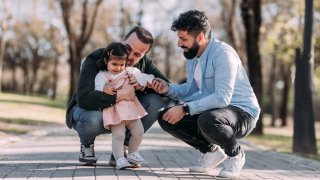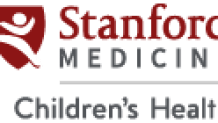

The following content is created in partnership with Stanford Medicine Children's Health. It does not reflect the work or opinions of the NBC Bay Area editorial staff. Click here to learn more about the fertility services at Stanford Medicine Children's Health.
In 2023 the American Society for Reproductive Medicine (ASRM) created waves when they issued an expanded description of infertility, characterizing the condition as “the need for medical intervention, including, but not limited to, the use of donor gametes or donor embryos in order to achieve a successful pregnancy either as an individual or with a partner,” effectively acknowledging infertility as a social condition as much as a physical one. This expanded definition is a meaningful step forward for diverse and non-traditional would-be families everywhere as it removes obstacles in accessing family-building assistance and infertility treatment. In fact, infertility and family building has come a long way since the first in-vitro fertilization (IVF) baby was born in 1978, perhaps just as much due to shifting cultural tides and LGBTQ+ acceptance as advancements in medicine.
The early days of fertility treatment
Get a weekly recap of the latest San Francisco Bay Area housing news. Sign up for NBC Bay Area’s Housing Deconstructed newsletter.
Advances in fertility medicine and IVF would not be possible without the evolving cultural attitudes that preceded it. When doctors in England delivered Louise Brown, the first human born through IVF in 1978, very little was known about fertility treatment outside of the medical community; people were afraid that babies wouldn’t be born healthy, and many made assumptions about Brown, like that she had supernatural powers or that she wasn’t fully human. Even some medical professionals feared that fertility treatments were a slippery slope that would lead to human cloning. Despite the media circus and backlash that accompanied this major milestone in fertility medicine, it didn’t hurt that the Browns were described as respectable, suitable, and deserving parents. Emphasizing their respectability and aligning IVF with traditional family values would help to ease it into the mainstream, eventually opening doors for more diverse and non-traditional families to participate in alternative methods of family building.
But before treatments like IVF became widely accepted for addressing infertility, prospective parents would need to shake the stigma of infertility. After struggling to get pregnant for nine years, Brown’s mother Leslie felt as though she was “not a real woman,” echoing the prevailing sentiment of adults experiencing infertility at the time. Over the following decades, a confluence of social movements like second and third-wave feminism, civil rights, and the LGBTQ+ rights movement would create a gradual shift towards more progressive views on family structures, effectively giving women and men everywhere permission to discuss infertility without shame. Since the birth of Louise Brown, it is estimated that over 8 million babies have been born through IVF. But according to Ruben Alvero, MD, Director of the Stanford Fertility and Reproductive Health Services at Stanford Medicine Children’s Health, the work is far from finished. “In 30 years, it’s never been better,” says Dr. Alvero, “although we have so much longer to go.”
Fertility treatment in the 21st century
Around 17.5 percent of the adult population worldwide experience infertility according to the World Health Organization, a number that is sure to grow thanks to the ASRM’s newly expanded definition of infertility to include LGBTQ+ and single would-be parents. According to Pew Research center, one-in-three American adults say they’ve used fertility treatments like IVF to grow their families or know someone who has. And yet, for marginalized communities, finding inclusive fertility programs like the Q+ Family Building clinic at Stanford Medicine Children’s Health can be quite difficult. It was only in 2008 that the California Supreme Court ruled that providers can’t deny access to fertility treatment due to the patient’s sexual orientation, and 2015 when the U.S. Supreme Court legalized same-sex marriages across the country, permitting same-sex couples to access many benefits previously denied to them and removing many obstacles in family building. Unfortunately, 1 in 8 LGBTQ+ people still live in states where doctors are permitted to deny them treatment.
“This is a community that has been turned away from fertility services for many years, and there are still clinics today that don’t see certain groups of the LGBTQ+ community across the country,” says Brent Monseur, MD, ScM, Director of the Q+ Family Building clinic at Stanford Medicine Children’s Health and chairperson for the ASRM LGBTQ+ Special Interest Group.
As a gay and non-binary individual themselves, Dr. Monseur is able to understand and better support their patients. They go on to emphasize the importance of finding clinicians who have the cultural competence and humility to treat members of the LGBTQ+ community: “If they’re able to find a clinic, they still have to find a clinician they feel comfortable with. For most LGBTQ+ patients that I see, no medical professional has ever asked them about their family building goals.” At Stanford Medicine, the Q+ clinic is challenging the status quo by offering not only industry leading fertility treatment, but also care that is culturally sensitive, socially aware, and inclusive.
Change on the horizon
Accessing costly family-building services as LGBTQ+ parents may depend on how insurance companies interpret infertility. This makes the ASRM’s expanded definition all the more critical according to Dr. Alvero, a board member of the American Society for Reproductive Medicine:
“[The ASRM] sets a lot of the clinical standards in reproductive medicine…so one of the goals was to have a practical effect on-the-ground, to have insurance companies see this powerful organization say ‘this is the definition of infertility that is broad and inclusive’ and we hope that it will have an impact throughout the world. Money is one of the big challenges [to accessing infertility treatment] and the hope is that insurance companies will see this and say ‘yes, we will cover this’.”
Today in the U.S. there are nearly 500 fertility clinics and tens of thousands of babies are born using reproduction technologies every year. More than 100,000 same-sex couples are raising children in this country, according to government data, and increasing numbers are looking to grow their families–a fundamental human right, regardless of sexual orientation, expression, or the need for assistive reproductive technologies.
“The AMA and the World Health Organization have said this is a disease just like any other disease, but what happens is folks say ‘well nobody is dying, nobody’s getting physically sick.’ That’s not right.” says Dr. Alvero. “This is an unseen injury…psychiatric studies and psychological studies have shown that it's every bit of a dissatisfaction as having cancer and other major diseases.”
Advocates believe the ASRM’s new definition of fertility will have wide-ranging impacts for LGBTQ+ couples looking to build a family, both with regard to legislation as well as the proliferation of inclusive and culturally sensitive clinics like the Q+ Family Building clinic. The future is hopeful, but Dr. Monseur knows change will take time.
“While I think this is the critically important first step for insurance companies to recognize that they need to do a better job of increasing access, it's not going to happen overnight. What’s really important is while it does help to push this change, it’s still going to be the job for advocates like myself and [Dr.] Ruben [Alvero] to really make sure that insurance companies hear these new definitions so that we can advocate for better coverage.”
Dr. Monseur anticipates that the clinic will inspire others to better serve the LGBTQ+ community:
“We hope that the Q+ Family Building clinic at Stanford Medicine will serve as a model for other academic centers across the country to develop programs aimed at providing specialized care and helping the sexual and gender minority population build their families.”
The Q+ Family Building clinic at Stanford is the first academic program entirely dedicated to LGBTQ+ family building in the U.S. The Q+ Family Building clinic team is committed to providing inclusive and culturally sensitive fertility services to the LGBTQ+ community and beyond. Click here to learn more.

